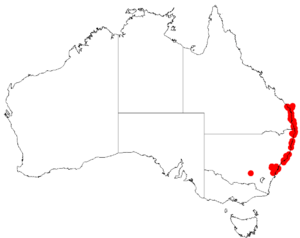Acacia baueri facts for kids
Quick facts for kids tiny wattle |
|
|---|---|
| Scientific classification | |
| Genus: |
Acacia
|
| Species: |
baueri
|
 |
|
| Occurrence data from AVH | |
The tiny wattle (Acacia baueri) is a small shrub found in eastern Australia. It's part of the Acacia plant family. This plant is also known as the tiny wattle because of its small size.
Contents
What the Tiny Wattle Looks Like
This small shrub usually grows to be about 0.1 to 1 m (3.9 in to 3 ft 3.4 in) (4 inches to 3 feet) tall. It can grow upright or spread out along the ground.
Instead of regular leaves, the tiny wattle has special leaf-like parts called phyllodes. These phyllodes are often arranged in circles or spread out along the stem. They are usually straight or slightly curved. Each phyllode is about 0.5 to 1.6 cm (0.20 to 0.63 in) (0.2 to 0.6 inches) long and 1 mm (0.039 in) (0.04 inches) wide.
The phyllodes are grey-green and feel a bit leathery. They are mostly smooth or have only a few hairs. Each one has a single groove running down its length.
Flowers and Seed Pods
The tiny wattle produces bright yellow flowers from July to September. These flowers grow in small, round clusters. Each flower cluster is about 3 to 5 mm (0.12 to 0.20 in) (0.1 to 0.2 inches) wide and contains 8 to 20 flowers. They grow on short stalks, about 2 to 6 mm (0.079 to 0.236 in) (0.08 to 0.24 inches) long.
After the flowers bloom, flat, thin seed pods form. These pods are slightly curved and are about 1 to 2.7 cm (0.39 to 1.06 in) (0.4 to 1.1 inches) long and 2.5 to 4 mm (0.098 to 0.157 in) (0.1 to 0.16 inches) wide. Inside the pods, the seeds are lined up, each with a thin thread-like attachment.
Naming the Tiny Wattle
The scientific name for this plant, Acacia baueri, honors two famous botanical artists, Franz and Ferdinand Bauer. They were known for their detailed drawings of plants.
Different Types of Tiny Wattle
There are two known types, or subspecies, of the tiny wattle:
- Acacia baueri subsp. aspera: This type is considered vulnerable in New South Wales. This means it needs protection to help it survive.
- Acacia baueri subsp. baueri: This type is considered vulnerable in Queensland. It also needs protection.
Where the Tiny Wattle Grows
The tiny wattle is found along the coast in eastern Australia. You can see it in central and northern New South Wales, stretching north from the Illawarra region. It also grows into southeastern Queensland.
It often lives on sandstone plateaus, which are flat, high areas made of sandstone rock. It likes rocky, open, or damp places. It's a common plant in coastal heathland communities, which are areas with low-growing shrubs near the coast. You can find it as far south as the Blue Mountains, near Sydney.

